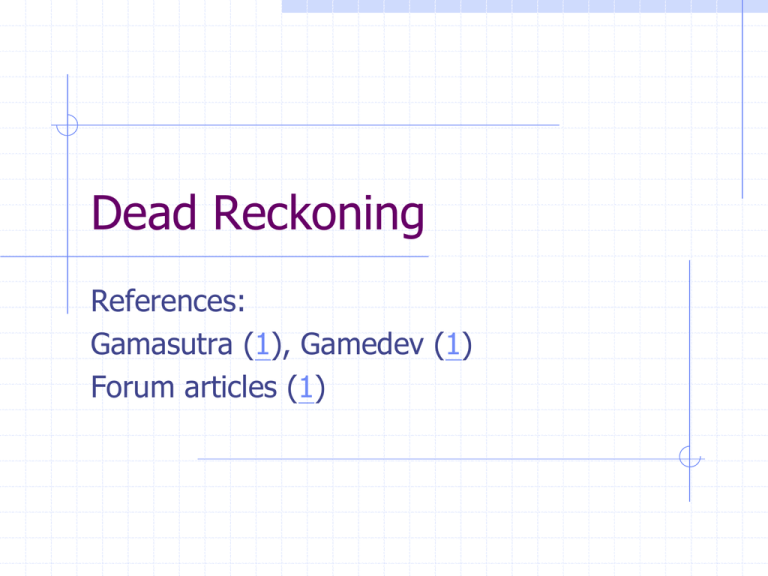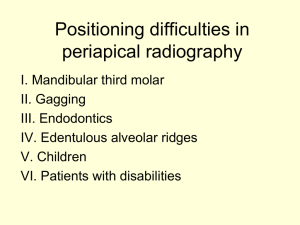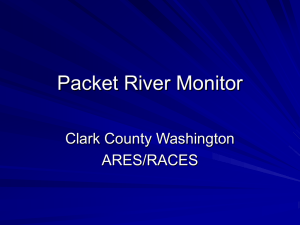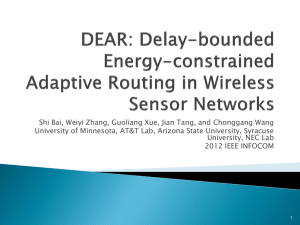Dead reckoning and smoothing
advertisement

Dead Reckoning References: Gamasutra (1), Gamedev (1) Forum articles (1) Introduction Fast-paced interaction in twitch games Players expect the level of performance of distributed games to approximate that of single computer/player game Solution: dedicated network (end-toend latency 150-200 ms) Fall 2012 2 Dead Reckoning From DIS (distributed interactive simulation) protocol of SIMNET project, DoD, USA Was for networking tank simulators Objectives: latency hiding, bandwidth reduction Basic Ideas: Fall 2012 Agree in advance on a set of algorithms that can be used by all players to extrapolate the behavior of entities Update threshold: how far reality should be allowed to get from these extrapolations before a correction is issued 3 Dead Reckoning If the motion is still within the DR threshold (on Owner), no updates required. Positiont1 Positiont0 [point-to-point] Positiont1 Positiont0 vt1 t0 [linear] 1 t1 t0 2 Position t1 Position t0 vt1 t0 2a Fall 2012 [quadratic] 4 DR Algorithm (point-to-point) New packet [p] New packet [p] No path Noticeably jerky unless one packet is received per frame Fall 2012 5 DR Algorithm (linear) moves along this v, until … New packet [p,v] Path does not consider change of velocity Fall 2012 6 DR Algorithm (quadratic) moves along this v and a, until … New packet [p,v,a] NewPosition = OldPosition + Velocity*time + 0.5*Acceleration*(time)2 Path does not consider change of acceleration – jerk Fall 2012 7 PDU (protocol data unit) Data packet representing each entity Kinematic state: position, velocity, acceleration, orientation Other info: damage level, turret … Which dead reckoning algorithm to use Threshold: jerkiness vs. more PDUs to be sent Fall 2012 8 Smoothing Jerkiness: due to sudden update of position Use smoothing algorithm to lessen the apparent jerkiness [more later] Fall 2012 9 Extension Predictive Contract State-based, rather than kinematic-based State: “drive along road to waypoint” If the definition of roads, the specific waypoint, the way of driving (right-side), … are known to all players, the vehicle could be computed w/o any network traffic Fall 2012 Others: “turn on/off the sensors”, “send out radio report” 10 Summary Dead reckoning is not free: every computer runs an algorithm to extrapolate each entity Trade processor cycles to reduced network use and apparent latency If all entities behave unpredictably all the time, DR offers little gain Fall 2012 11 DR Smoothing with Cubic Splines (ref) Jerkiness is due to the sudden update of position The following method ensures smooth positional transition while ensuring accuracy by packet (server) updates Only cubic (parametric) curve can represent R3 curve [quadratic curves are planar] Hermite curves are most common. Two points and their corresponding tangents need to be specified (by quadratic kinematics laws) Fall 2012 12 A Draftsman’s Spline Fall 2012 13 Math of Hermite Curves h1(s) = 2s33s2 + 1 h2(s) = 2s3 + 3s2 h3(s) = s3 2s2 + s h4(s) = s3 s2 P(s) = P1h1(s) + P2h2(s) + T1h3(s) + T2h4(s) P’(s)=P1h1’(s) + P2h2’(s) + T1h3’(s) + T2h4’(s) h1’ = 6s2 6s h2’ = 6s2+6s h3’= 3s2 4s+1 h4’= 3s2 – 2s Note: end tangent vectors are dP/ds Fall 2012 14 Reparameterization If theparameteris t (time): t dt s ds T T p(t ) P( s (t )) dp(t ) dP( s ) ds dP( s ) 1 dp(t ) dP( s ) ds velocit y dt ds dt ds T dt ds dt dP dp (1) T (T ) ds dt s=1 t=T Fall 2012 s=0 t=0 dP dp ( 0) T ( 0) ds dt 15 Algorithm When a packet [p,v,a] arrives, begin creating a cubic spline for next position Approximate (extrapolate) the [p,v] after time T A piece of Hermite curve is defined by two end points and two end tangents Fall 2012 P1: current position T1: (scaled) current velocity P2: extrapolated position after T T: estimated interval T2: (scaled) velocity after T between packets 16 Details Move with current spline P2 T2 The position gradually changes from P1 (s=0) to P2 (s=1, t=T) T1 P1 New packet [p,v,a] Start a new spline by 1. Current [p,v] 2. New [p,v] computed by [p,v,a] after time T Fall 2012 17











